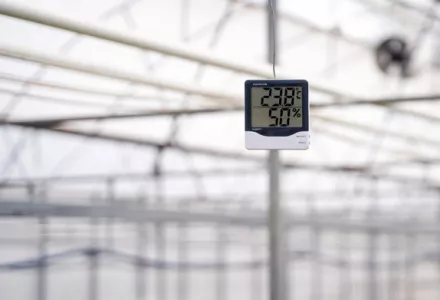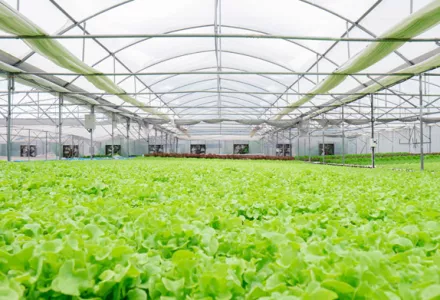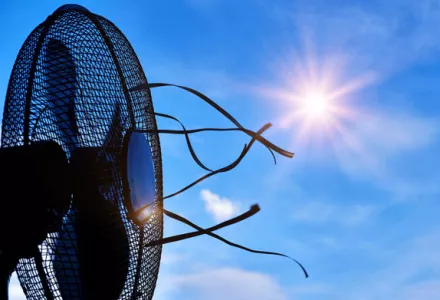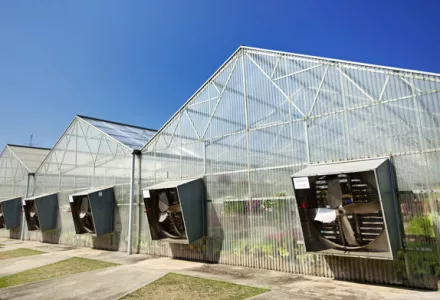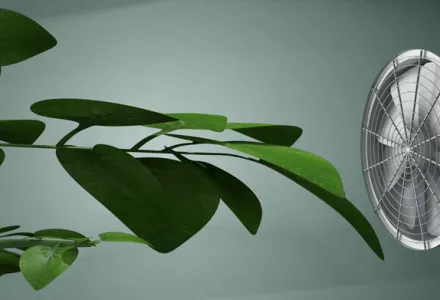The best systems give lots of thought to ventilation, although not necessarily a lot of money and this must always start at the beginning stages of planning a growing environment. Ventilation creates and controls the environment in which the plants and crops are grown in. As such, it deserves a little more attention than it tends to get. There are 2 parts to the discussion, the first are the principles of ventilation, the ‘where, why and what’ part of the question.
What are the goals behind ventilation, what is the purpose? Well, ventilation moves the air around, so how does this help? There are two basic modes of action of ventilation, or rather two basic systems in how ventilation works: the first being an Open system where air is exchanged and the second being a closed system where no air exchange happens. Circulation refers to the movement of the air, achieved either in a closed or an open system. Air Exchange is the actual exchanging of the physical air in one defined location for a new air mass.
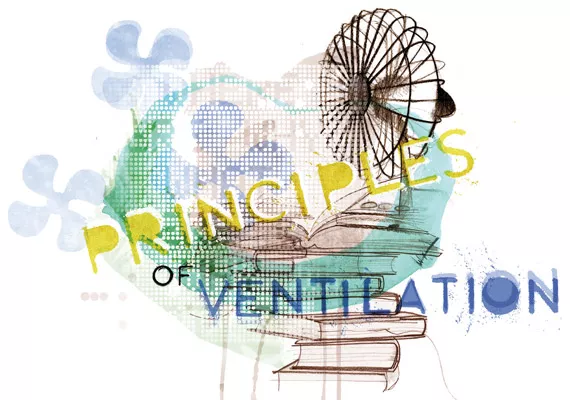
Circulation
Circulation basically transfers things like heat, humidity, and biology from one area to another. Air that sits still for any amount of time begins to separate: a process known as stratification which effects both temperature and gas composition (read also: How air temperature affects plants). This can lead to situations such as thermal layering and deficits of critical gases such as Oxygen or Carbon dioxide.
Watch our video: How does air circulation affect plant growth?
Air Exchange
Air Exchange, on the other hand, is basically the same thing, well almost. Exchange (Open ventilation system) is used to replace air from one area with the atmosphere from another area, and the air moves around in the process creating circulation. Temperature, gas exchange, and humidity can all be affected positively through the exchange process.
Open & Closed air systems
In a closed system; indoors, in a room or in a greenhouse, the principles remain the same. It is all about growing plants in a controlled area. Plants need light and water to grow and survive. Plants take in light, and take up water, and ‘breathe’ (read also: carbon dioxide supplementation mostly CO2 and a little Oxygen and use these four components to produce energy from the light and carbohydrates. They then store that energy, to serve as basic building blocks for all the growth to come. During respiration, Oxygen is used, CO2 is released, and the energy from those stored building blocks is made available so that the plant can actually grow. In doing this, plants cause an imbalance of gases at the leaf / air interface zone, so that the humidity and generally temperature is higher closer to the plant.
In a closed system, the circulatory effect serves to mix the air close to the plant with the air further away, but in the same room or vented area, acting to moderate the temperature, equal out the humidity, and replace the depleted gas areas at the leaf surface with normal air to insure Carbon dioxide and Oxygen are available for those very basic of life processes. This process does not replace the gases that are used up. It also does not remove the increase in heat packets (BTUs, British Thermal Units), or remove the water from the air; it just mixes it to cut out layering effects or depletion zones.
On the other hand, where a room or area can replace the air in the area of concern with drier air, or cooler air, then the effect is the removal of the moisture or heat from the system overall. Open systems will accomplish both and is based on the air that is replacing the current room. Circulation is used all the time to keep things moving and fairly equal, and air exchange is used to control when the temperature or humidity gets out of hand. Even when a mostly air tight room sits at a perfect temperature and humidity all the time, it still has to be vented on a schedule to replace the loss of the critical gases such as Oxygen and Carbon dioxide. Understand that even when the need is to raise the temperature or increase the moisture, the effect is the same since it is based on the air that is replacing the room air and will be affected up or down accordingly.
Unfortunately, when control of a single element is required, it may negatively affect other needs so balance and priority become the by words. If a grower should supplement the Carbon dioxide in the facility to increase the growth rate, then exchanging air becomes harder without decreasing the CO2 that was released, a waste of both time and money. It might be necessary to work with a prioritized system that gives precedence to one element over another at certain times.
Other functions of ventilation:
There are other functions that ventilation accomplishes through both circulation and Open / Closed systems. These secondary items are still based on one of the first 2 effects, that of affecting humidity. These are:
- Disease control
- Controlling growth / Evapotranspiration
- Stress control
1. Disease control
By controlling humidity and temperature, particularly humidity, the preferred environmental conditions for various disease vectors and pathogens are also limited. Free moisture is kept from setting a film on the leaf surface limiting the ability of the spores from fungi like Powdery Mildew and anthracnose from germinating and gaining entrance into the leaf tissue interior. Hidden environments are also humidity controlled. Spores from various pathogens will degrade as they sit in less than perfect conditions, decreasing effective rates. Some pathogens are disrupted at lower humidity values such as the group of water molds including Phythium and Phytophthora; they might continue their activity internal to the leaf, but not externally. Insect activity can and will also be affected by humidity levels, which affect general survival and reproduction rates of key problem insects such as the general class of mites as well as less problematic insects such as Fungus Gnats. Humidity also affects another area critical to plant growth and development.
2. Controlling growth/Evapotranspiration
Evapotranspiration is the process that drives and controls the movement of water, or fluid, through the plant from the roots till it exits at the stomata on the leaves. Water, picked up in the roots, and loaded up with nutrients and materials for plant growth are pulled to the top part of the plant by the fluid evaporating from specialized pores on the leaf, stomata (stomates), based on the humidity level in the air at the stoma (stomate), much like water through a straw. The drier the air, the faster the evaporation, the higher the negative pressure at the stoma, and the faster water pulls up to replace it, bringing along the nutrients needed for plant growth. If the need for transport is high and the humidity is also high, then the water moves slow and not fast enough for good replenishment of nutrients and water. Also, if the air is too dry then the water moves too fast and the level of ions, that are salts, accumulates in the leaves, or the water just cannot move fast enough and the tissue can and will burn. This process controls the growth of the plant, acting like the throttle on the pipeline that supplies or moves the water and nutrients inside the plant tissue. Are you using a nutrient tank? Read the article is it worth using air injection in your nutrient tanks?
3. Stress control
Stress is also a critical component of plant development, exerting both negative and positive pressure on the plant. Some stress is required to grow a strong plant: making plant stems strong, controlling crop growth and uniformity, and encouraging competition. Some air movement, the circulatory kind that exerts pressure on the plant itself, causes the plant to react. This is stress in action. It results in the plant strengthening its supportive tissue as well as doing all those things to increase its odds of survival to flower from developing bigger fruits with faster ripening (with stronger stems for support of those fruit) to increasing the metabolites the plant normally produces to protect it and increase reproductive potential. Too much stress is not so good, too little stress is just as bad. Circulation can help express a ‘just right’ amount of stress.
Geographical areas and seasons
It may be the case that instead of an open ventilation system that depends on the exchange of air to accomplish goals in temperature reduction or in humidity control, a closed system would work better. A closed system is used in cases where Carbon dioxide (CO2) is being replaced internally and temperature is regulated through AC units and heat through heat systems. One or both of these systems, along with humidifying / dehumidifying systems can and usually are required on most growing setups. You can read here more about carbon dioxide (CO2) applications in indoor growing.
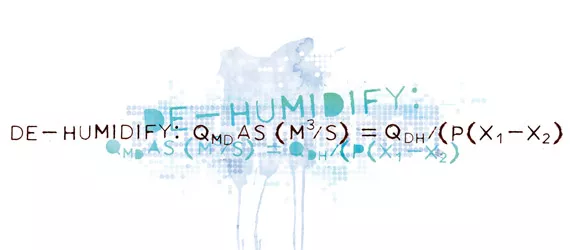
In cooler areas, AC is less required and vice versa for warmer areas where heating is a bigger concern. Dehumidifying is typically required in most places; humidifying equipment is usually a need in colder areas during heating seasons, and some other areas that are normally arid locations. In closed loop systems, not only does the temperature burden become much larger, all other elements in a normal atmosphere must be monitored and maintained.
Figuring out what you need
Now, the fun part, how to figure out what is needed to do the job. Well, short of a course in Engineering, it is not going to come from a few paragraphs here. The formulations are very specific to the situation and need. Formulas for figuring even simple steps such as the air flow rate needed for cooling (m3/s) qc = Hc/(p cp (to – tr)) are meaningful but the right know-how is needed to understand their purpose. It is required that many things are known, things like BTU loads, design temperatures, air flow resistance, air density, moisture loads, seasonal averaging, and lots more. The designer of a proper operation should consult with proper sources to design what is needed. The cost of throwing money in improper designs, field changes over time, and covering the cost of mistakes in production loss, excessive costs, and lack of consistency will be enough to cover the extra design help and extra cost in installing the correct system that matches the need. Even a little investigation into the need would be better than nothing.
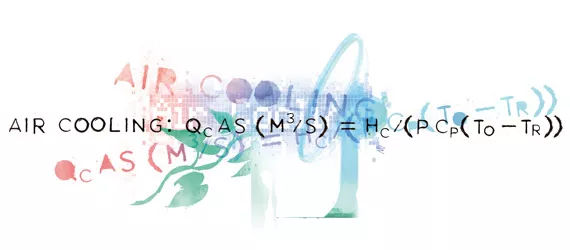
Ventilation has to deal with all those things discussed here. While designing the system to use, keep in mind all the factors that will be affected.
- Where will the exchange air be pulled from, and where will it be exhausted?
- How will the use of CO2 be built into a system that also requires a greater heat load during the same period?
- How large of an AC system or heat system is needed? How will it be controlled?
- What will the ducting look like and how will it run?
These are all questions that the grower needs to know and in doing, guarantee less headaches and an easier run at production. Putting it all together is the practical side of ventilation.

